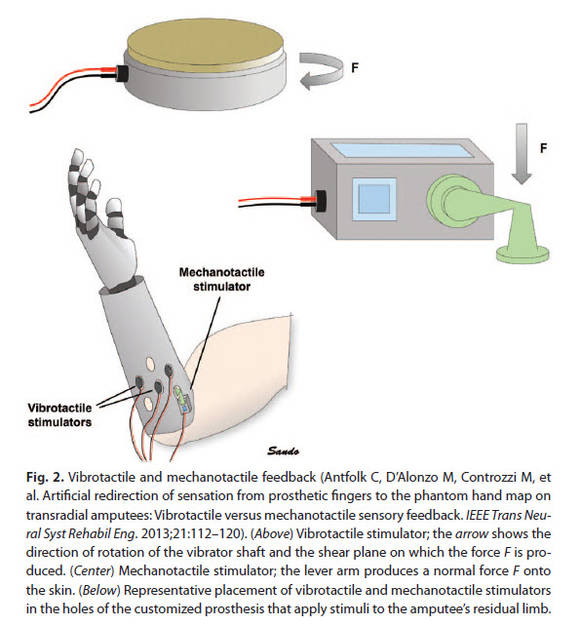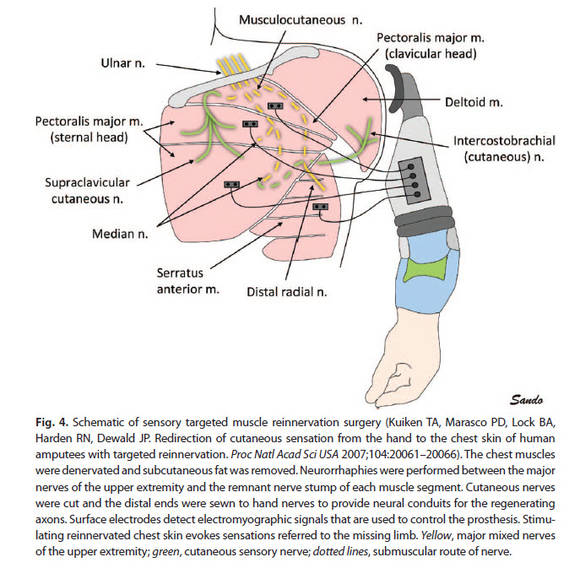미국 미시건 대(University of Michigan)의 연구자들이 감각 피드백을 제공할 수 있는 인공 보철 장치를 설계하는 새로운 방법을 탐색하고 있다. 촉감을 가지는 인공 보철 장치를 개발하는 초석이 되는 이러한 연구결과는 미국 성형외과학회(ASPS: AMERICAN SOCIETY OF PLASTIC SURGEONS)가 출판하는 한 학술지(명칭: Plastic and Reconstructive Surgery)에서 2015년 6월 특별호로 발표되었다.

부상하고 있는 감각 피드백 기술은 감각의 일부를 제공하여 인공 보철 장치를 좀 더 자연스럽고 직관적으로 사용할 수 있도록 만들 것이라고 미국 성형외과학회(ASPS) 회원 성형의사이자 미시건 대의 의학박사인 폴 세데르나(Paul S. Cederna) 및 동료 연구자들이 검토 논문(review paper)에서 기술하였다. “이러한 혁신은 감각 능력을 가지는 인공 보철 장치를 개발하는 길을 마련한다”고 연구자들이 기술하였다.
[인공 보철 장치에 감각을 제공할 수 있는 신경 인터페이스]
여러 절단 수술 가운데에 팔을 잃는 것은 특히 파괴적인 형태이다. 왜냐하면 사람의 팔은 일상생활의 기능, 의사소통, 다른 인간의 독특한 속성 등을 위한 도구이기 때문이라고 미시건 대의 폴 세데르나 의학박사와 다른 공동 저자들이 전했다.
그리고 대부분의 팔 절단은 젊거나 건강한 사람들에게 시술되는 경향이 있으므로 기능적, 심리학적, 경제적, 사회적 영향이 훨씬 더 크다.

현재의 로봇 보철 장치는 인간의 손이 제공하는 정교한 다재다능함을 구현하고자 한다. 그러나 이러한 운동 분야 발전은 인공 팔다리에 감각 피드백을 제공하는 탐지 분야의 발전을 훨씬 앞서는 것이다. “감각의 부재는 자연스런 팔다리가 가지는 완전한 기능성을 재현하는 데에 있어 중요한 제한 사항”이라고 폴 세데르나 의학박사와 다른 공동 저자들이 기술하였다.
인공 보철 장치에 촉감의 일부를 제공하는 것은 동작을 시작하고 감시하기 위하여 단지 시각만을 의존하는 인지 부담(cognitive burden)을 감소시킬 것이며, 더불어 환자에게 엄청난 심리적 편익을 제공할 것이다. 검토 논문은 인공 보철 장치에 감각을 제공하기 위하여 말초 신경에 센서 인터페이스를 만드는 최신의 기술 및 부상하고 있는 기술을 집중적으로 다루었다.
이미 사용되고 있는 기술로는 한 형태의 감각이 다른 형태의 감각으로 대체되는 ‘감각 치환(sensory substitution)’이라고 불리는 기법이 있다. 예를 들어, 남아있는 팔에 있는 피부 또는 신체의 다른 부분에 인가된 진동이 인공 보철 장치 상에 있는 센서로부터 촉감을 전달하는 데에 사용되고 있다.
다른 기법들은 인공 보철 장치 상에 있는 센서에 의하여 자극되는 신경 내부 혹은 신경 근처에 위치한 전극과 같이 이식된 다양한 형태의 신경 인터페이스를 이용한다. 이와 같은 직접적인 신경 자극 방법은 환자가 강성, 형상, 크기 등과 같은 물체의 특성을 느끼게 하거나, 시각적인 단서 없이도 정교하게 운동의 동작을 제어할 수 있게 만드는 데에 유망하다.
더 새로운 유망한 방법으로 ‘선별적인 근육신경 재자극(TMR: targeted muscle reinnervation)’이 있다. 이 방법은 온전한 근육과 덮여있는 피부에 감각을 제공하기 위하여 신경이 이전된다. 선별적인 근육신경 재자극(TMR)은 원래 인공 보철 장치에 대한 제어를 향상시키기 위하여 개발되었으며, 인공 보철 장치로부터의 센서 피드백을 이끌어내기 위하여 연구되고 있다.
신경 전극의 필요성을 회피하기 위하여 실험적 방법이 탐색되고 있다. 저자들의 연구실은 생물학적 요소를 가지는 인공 인터페이스가 직접적으로 인공 보철 장치 센서로부터 남아있는 신경으로 감각 신호를 전달하는 ‘감각 재생 말초 신경 인터페이스(sRPNI: sensory regenerative peripheral nerve interface)’라고 불리는 기법을 사용하고 있다.
또 다른 차세대 방법은 특정한 광 파장(light wavelength)을 이용하여 신경 신호를 제어하는 ‘광유전 기술(optogenetic technology)’을 이용하는 것이다. 비록 이 방법이 현재까지 동물에서만 연구되고 있지만, 광유전 기술은 신경에 대한 직접적인 전기 자극이라는 기존 방법에 대한 설득력 있는 대안을 제시하고 있다.
“궁극적인 목표는 복잡한 운동 명령을 수행하는 능력뿐만 아니라 의식적인 감각을 이끌어 내는 능력 측면에서 본래의 팔다리를 근접하게 모사하는 인공 보철 장치를 개발하는 것”이라고 폴 세데르나 의학박사와 다른 공동 저자들이 기술하였다.

비록 충족되어야 할 많은 연구 과제들이 남아있지만, 연구자들은 선별적인 근육신경 재자극(TMR ), 감각 재생 말초 신경 인터페이스(sRPNI), 광유전 기술 등과 같은 더 새로운 기술들이 미래의 파고를 대변하는 것으로 감각 피드백을 통하여 인공 보철 장치에 대한 좀 더 직관적인 제어를 달성하는 데에 초석이 될 것이라고 덧붙였다.
[관련 논문의 서지 정보]
Bao Tram Nghiem, Ian C. Sando, R. Brent Gillespie, Bryan L. McLaughlin, Gregory J. Gerling, Nicholas B. Langhals, Melanie G. Urbanchek, Paul S. Cederna. Providing a Sense of Touch to Prosthetic Hands. Plastic and Reconstructive Surgery, 2015; 135 (6): 1652 DOI:10.1097/PRS.0000000000001289
Prosthetic hands with a sense of touch? 'Sensory feedback' from artificial limbs
Date: May 29, 2015
Source: Wolters Kluwer Health: Lippincott Williams and Wilkins
Summary: Researchers are exploring new approaches to designing prosthetic hands capable of providing "sensory feedback." New advances have been made toward developing prostheses with a sense of touch.
Researchers are exploring new approaches to designing prosthetic hands capable of providing "sensory feedback." Advances toward developing prostheses with a sense of touch are presented in a special topic article in the June issue of Plastic and Reconstructive Surgery®.
Emerging sensory feedback techniques will provide some sensation and enable more natural, intuitive use of hand prostheses, according to the review by ASPS Member Surgeon Paul S. Cederna, MD, of University of Michigan, Ann Arbor, and colleagues. They write, "These breakthroughs pave the way to the development of a prosthetic limb with the ability to feel."
'Nerve Interfaces' May Allow Feeling in Prosthetic Hands
Upper limb loss is a "particularly devastating" form of amputation, since "a person's hands are their tools for everyday function, expressive communication, and other uniquely human attributes," according to Dr. Cederna and coauthors. The functional, psychological, economic, and social impact is even greater since most upper limb amputations occur in young, otherwise healthy individuals.
Current robotic prostheses approach the fine dexterity provided by the human hand -- but these advances have outpaced developments in providing sensory feedback from artificial limb. "The lack of sensation…is the key limitation to reestablishing the full functionality of the natural limb," Dr. Cederna and colleagues write.
Providing some sense of touch to the artificial hand would lessen the "cognitive burden" of relying solely on vision to initiate and monitor movements -- while also providing "tremendous psychological benefits" for patients. The review focuses on recent and emerging technologies to create "sensory interfaces" with the peripheral nerves to provide feeling to prostheses.
Already in use is a technique called sensory substitution, in which one type of sensation is substituted for another. For example, vibration applied to skin on the remaining limb, or to another part of the body, is used to convey touch from sensors on the prosthesis.
Other techniques use various types of implanted neural interfaces -- electrodes placed in or around the nerves -- which are stimulated by sensors on the prosthesis. These direct neural stimulation approaches show promise in enabling patients to feel object characteristics such as stiffness, shape, and size, or to control fine-motor movements without visual cues.
A promising newer technique is targeted muscle reinnervation (TMR), in which nerves are transferred to provide sensation to intact muscles and overlying skin. Originally developed to improve control of the prosthesis, TMR approaches are being studied to elicit sensory feedback from the prostheses.
Experimental approaches seek to avoid the need for nerve electrodes. The authors' lab is working on a technique called the sensory regenerative peripheral nerve interface (sRPNI), in which a "bioartificial interface" transfers sensory signals directly from a prosthetic sensor to the remaining nerve.
Another "next generation" approach is the use of optogenetic technology to control nerve signaling using specific light wavelengths. Although studied only in animals so far, optogenetics offers a "compelling alternative" to direct electrical stimulation of nerves.
Dr. Cederna and coauthors write, "The ultimate goal is to develop a prosthesis that closely mimics the natural limb, both in its ability to perform complex motor commands and to elicit conscious sensation." While many research challenges remain to be met, they believe that newer techniques like TMR, sRPNI, and optogenetics "represent the wave of the future, paving the way to more intuitive prosthetic control through sensory feedback."
